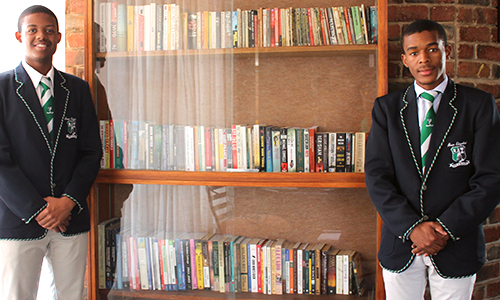
Bongani Mtotoba (left) and Sinoxolo Gcilitshana (right) at the first-ever 24 hour in-house library at Khayalami residence. The librarian and Deputy Residence Head respectively hope to revive the culture of reading on our Bloemfontein Campus.
Photo: Valentino Ndaba
“It is said that reading means to the brain what exercise means to the body. For that reason, we want to bring back the culture of reading to our students who are, after all, the future replacement of the leadership of our wounded and broken country,” said Sinoxolo Gcilitshana, Deputy Residence Head, and Prime of Khayalami.
Titles such as A Life Ever Lasting by Miranda Hearn, To Live Free by William Wilberforce, Powers of Darkness Powers of Light by John Cornwell, and Character Counts by Charles Dyer are among the 228 inspirational books on the shelves of Khayalami residence’s library. Tuesday 12 April 2016 was a proud moment for the residence as it launched the first library in the country located within a university residence on the Bloemfontein Campus of the University of the Free State.
Last year, Dimpho Jasa, a resident at Khayalami, approached Sinoxolo, who then held the Residence Committee (RC): Academics portfolio, with an idea of forming a book club. Sinoxolo had suggested that a library be established in order to make the book club sustainable. That conversation served as a foundation of the 24 hour in-house library.
“We started with five books last year,” said Sinoxolo, “and ever since we sent the message out, the Vice-Chancellor and Rector, Prof Jonathan Jansen has been supporting us together with the Vice-Rector, Prof Nicky Morgan, as well as the Dean of the Faculty of Education, Prof Sechaba Mahlomaholo, and the Head of the Department of English, Prof Helene Strauss.”
Now, more than 170 young men have access to a growing library that is expected to hold 1500 books by September, when Sinoxolo steps down as the Prime. According to Bongani Mtotoba, the RC: Academics and librarian, some residents have made pledges to help expand the collection. “The response has been quite positive from the guys,” he said.
Borrowers are required to submit a book review upon returning the book. This feedback will be compiled by the English Department into a book available to the public.
Khayalami’s pioneering spirit has also seen the residence run a successful writing competition in 2015. It has since been introduced to the rest of the East College, and now will take place annually.
For more information on how to donate books or enter the writing completion, contact Sinoxolo on 0783332203 or semsinoxolo@hotmail.com.